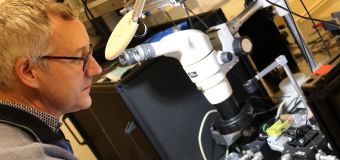You are here
Micro-soufflage de verre pour la réalisation de composants optiques miniatures
A team of researchers from FEMTO-ST has developed miniature conical lenses by revisiting glass-blowing techniques practiced since Roman times.
For centuries, glass blowing is, indeed, a technique for making glass parts in volume. A FEMTO-ST research team recently applied it on a microscopic scale to collectively produce a particular optical component, a miniature axicon, on the same substrate.
This component is in fact a conical microlens whose profile allows to generate quasi-Bessel beams, that is to say non-diffracting beams. This allows to create a miniature light saber or a light needle.
In an article published on June 25, 2019 in Optics Letters (and selected by the Optical Society of America in its News Releases), researchers presented a technique for manufacuring miniature axicons based on glass blowing. from structured micro-cavities in a silicon substrate and sealed with a glass substrate. When the stack is highly heated, the expansion of the trapped gas, combined with the drop in glass viscosity, forms bubbles used as pistons to generate and control a profile on the opposite side of the glass substrate. Once the pistons removed by polishing, hundreds of axicons can be obtained on the same substrate. Robust, they are destined to be integrated in more complex microsystems for medical imaging or in the extension of machining performance.
“Microscopic Glass Blowing Used to Make Tiny Optical Lenses”, Optics Letters News, June 2019. https://www.osa.org/en-us/about_osa/newsroom/news_releases/2019/microscopic_glass_blowing_used_to_make_tiny_optica/
Article: J. V. Carrión, J. Albero, M. Baranski, C. Gorecki, N. Passilly, “Microfabrication of axicons by glass blowing at a wafer-level,” Opt. Lett., 44, 13, 3282-3285 (2019).
DOI: https://10.1364/OL.44.003282.
More informations : Nicolas Passily



















